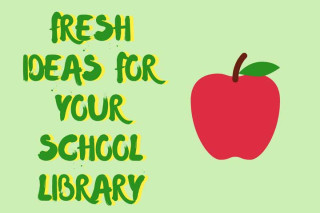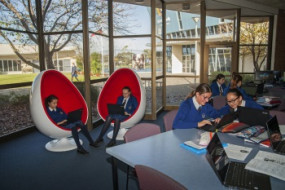- Your School Type
- Solutions
- Resources
- Blog
- Events
- More
- Contact Us
- Book a Demo
- Get a Quote

The school library is often described as the heart of the school, and it isn’t hard to see why. In addition to being a place of learning for students and staff from all faculties and year levels, the school library can provide a comfortable, nurturing space in which to dream, play, explore, and create.
Findings from Softlink’s UK School Library Survey and Australia, New Zealand and Asia Pacific School Library Survey (collectively: SLS) over several years clearly indicate the library’s value as a centre for community, exchange and growth within the school: in 2017 and 2018, over 90% of respondents in both surveys agreed that provision of a learning centre and space is an ‘important’ or ‘very important’ service that the library provides.
As firm believers in the vital role of school libraries for student success, Softlink is proud to support two very important school library advocacy initiatives, the Students Need School Libraries campaign in Australia and the Great School Libraries campaign in the UK. We’ve worked with the coordinators of these campaigns to produce resources aimed at parents and the community, including this printable flyer and this short video. We encourage you to use and share these resources to help spread the message that school libraries really matter.
Like anything important, the library needs care and attention to function at its best. As one SLS respondent from Australia shared:

For this blog post, we’ve gathered some suggestions and examples from SLS responses and experts in school library design, which we hope will encourage you to continue working to make your library even better, and maybe also inspire you to try something new.
We always love hearing from our readers about innovative practice in the school library space, so if you have something to share, please don’t hesitate to connect with us on Twitter @SoftlinkEdu or send us an email!
Library consultant Kevin Hennah works with libraries on strategies to maximise productivity of space, improve presentation of resources, and maintain relevance. Kevin believes thoughtfully selected furniture, outward-facing displays and clear signage are among the key design elements libraries can use to be more attractive to younger audiences and ensure print collections retain their appeal alongside digital technologies.
SLS respondents have shared that their efforts to reinvigorate the library space have had a positive effect on borrowing and library use. For example, one 2017 respondent commented:
If you’re looking for tips on getting started, this article from SchoolNews.com includes advice from a number of library design specialists and provides a handy checklist of questions to consider in relation to the library space.
This website by New Zealand Ministry of Education covers in greater detail the main aspects to consider when designing innovative spaces for learning, with video case studies from several schools. On this page they share evaluations 1 year after a new build or major redevelopment is finished to help refine and improve their design process for future builds, including evaluations for Hobsonville Point Schools. In this case study for Softlink, Hobsonville Point Schools Past Teacher Librarian, Georgi de Stigter, shares why the schools chose Oliver v5 as their library management system and how the software enables them to meet students needs in a constantly evolving future-focused school environment.
It’s well known that a major role of school libraries is to support teaching and learning in the different subject areas. What may be less familiar, though, is the idea that the faculties can support the library through subject-centred practical learning projects.
The possibilities are endless!
For example, art departments could design projects where students’ work is used in library displays; textile students could hone their skills creating cushions and curtains for a cosy reading nook or even props for a creative play/makerspace area; technology students could mentor younger students in library-based coding workshops; and business students could try their hand at running a coffee shop, recycling program or other simple enterprise from the library.
As Teacher Librarian Sunny South writes in an article for Scan magazine:
Sunny’s article offers a variety of ideas to explore the potential of flexible library spaces through collaboration and project-based approaches.

In this article, Maria Pepe-Micholos and Peter O’Toole previously from St Michael’s College Henley Beach in Adelaide, South Australia, share how they incorporated various flexible and positive design principles when planning their new Secondary Campus Resource Centre (pictured).
Many SLS respondents shared similar stories of thoughtful, collaborative design and innovative uses of the library space, including the following successes:
With sustainability in schools identified as a cross-curriculum priority in the new Australian Curriculum and increasing demand for sustainable practice in many areas, there is even more reason for school libraries to offer resources and activities that support environmental awareness and sustainable principles.
Kardinia International College library does this in a simple yet effective way, by providing new students with seed bookmarks and an incentive to cultivate gardening skills, with a fun competition and prizes for the healthiest seedlings (pictured below).
Other schools recognise and encourage the benefits of combining two of life’s simple pleasures: reading and spending time outdoors.
Who wouldn’t love the opportunity to sit outside and enjoy a good book? Teacher Librarian Megan Daley has compiled a fantastic list of books that focus on gardening with young children, issues of the environment, and sustainability in general. The accompanying blog post includes links to other gardening-focused resources too, as well as insights from Megan’s own experiences of gardening with children.
For more inspiration check out this playlist of videos featuring school garden projects from Edutopia. This Sustainable Schools page has more helpful information, including teacher resources, as well as funding opportunities for Australian schools to support sustainability initiatives.

There are so many examples of school libraries taking the lead when it comes to exploring new technologies, design thinking, and other innovative practices in schools. Here is a small selection of comments from School Library Survey respondents around the world:
On her TinkeringChild.com blog, Teacher Librarian Jackie Child shares a range of advice, examples and thoughts based on her experiences implementing digital tech and makerspace activities in the library at St Aidan’s Anglican Girls’ School where she and Megan Daley are teaching partners. There’s also a list of Jackie and Megan’s recommended books for a makerspace.
Have you developed successful strategies to ensure your school library is a vibrant, welcoming space for learning? Share with us on Twitter @SoftlinkEdu
Editor’s note: This post was originally published 16 May 2018 and has been updated April 2019 for freshness, accuracy, and relevance.